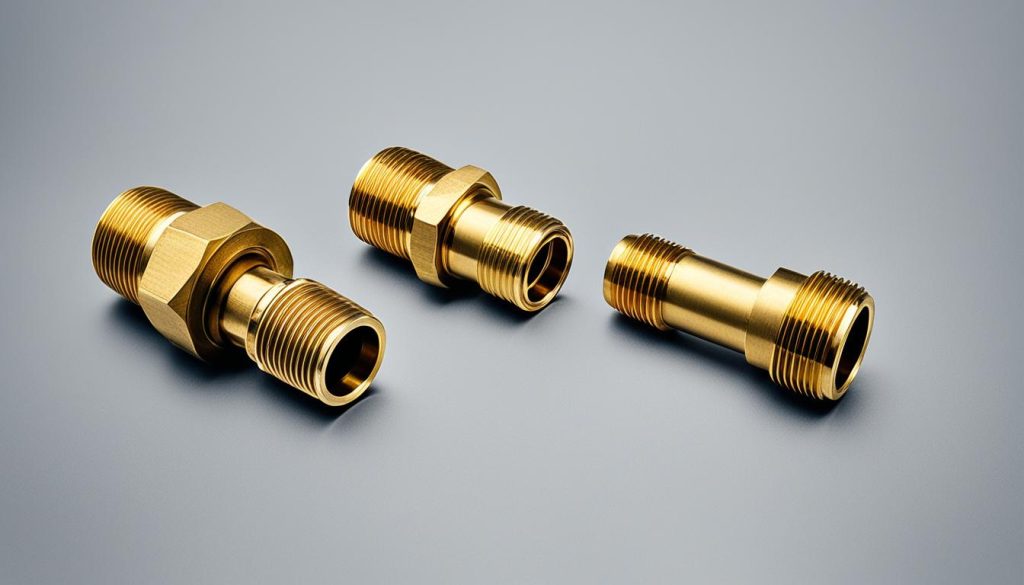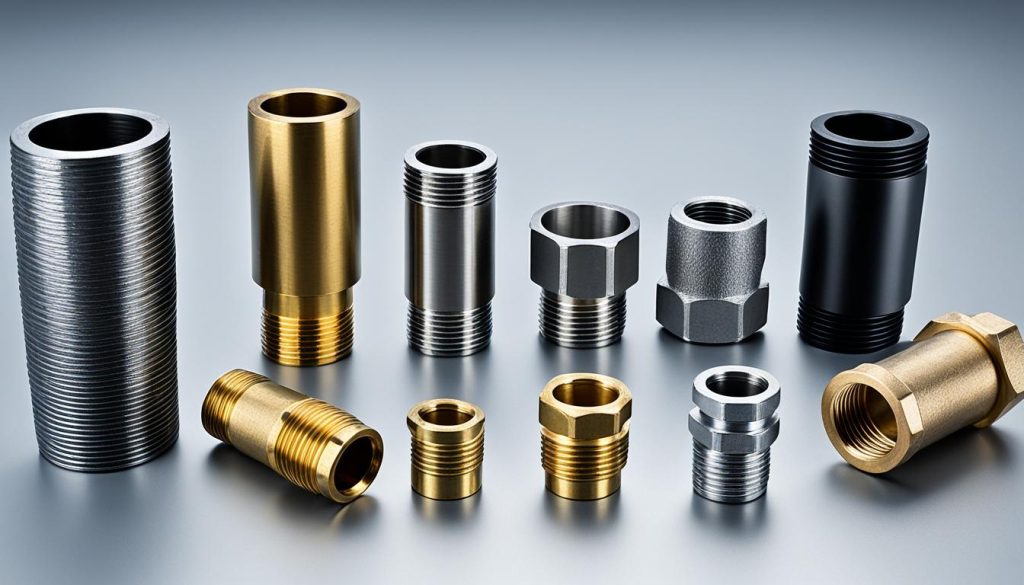Understanding Nipple in Plumbing – Essential Guide
Did you know that in plumbing, a nipple is not just a body part but actually a vital component of the plumbing system? It plays a crucial role in connecting fittings and fixtures, ensuring efficient fluid or gas flow. Let’s dive into the world of plumbing nipples and unravel their importance, types, materials, and applications.
Key Takeaways:
- A nipple in plumbing is a short piece of pipe with male threads on both ends used to connect fittings or fixtures.
- Nipples come in various types, including barrel nipples, weld nipples, hex nipples, and hose nipples.
- Thread types like NPT and BSPT are important considerations when choosing pipe nipples.
- Pipe nipples can be made from materials like brass, stainless steel, and PVC, each offering different levels of strength and durability.
- Pipe nipples find applications in various industries, such as chemical processing, food and beverage, and machine building.
Types of Pipe Nipples and Their Uses
When it comes to plumbing, there are various types of pipe nipples that serve specific purposes. Understanding these different types can help ensure the proper selection and installation for your plumbing needs. Let’s explore some common types of pipe nipples and their uses.
1. Barrel nipples: Barrel nipples are used in tight spaces where a close connection is required. They are often used in plumbing systems with limited room for fittings or fixtures.
2. Close nipples: Close nipples are similar to barrel nipples. They have a short length and are used to connect two fittings tightly together.
3. Weld nipples: Weld nipples are designed for extreme conditions, such as high vibration or temperature changes. They are welded into place, providing a secure and durable connection.
4. Toe pipe nipples: Toe pipe nipples have one end threaded, and the other end is left plain. They are commonly used in boiler systems.
5. Shoulder pipe nipples: Shoulder pipe nipples have a larger diameter shoulder in the middle, making them suitable for applications where extra strength and stability are required.
6. Hex pipe nipples: Hex pipe nipples have a hexagonal nut in the middle, allowing for easy installation and tightening. They are commonly used in plumbing systems that require a strong connection.
7. Right-left hand pipe nipples: Right-left hand pipe nipples have threads of different orientations on each end. They are used to connect fittings or fixtures with different thread directions.
8. Swage pipe nipples: Swage pipe nipples have one end larger than the other, allowing for a transition in pipe size. They are often used to connect pipes of different diameters.
9. Seamless pipe nipples: Seamless pipe nipples are made from a single piece of pipe, providing a smooth and uninterrupted flow of fluids or gases.
10. Combination/king pipe nipples: Combination/king pipe nipples have one end threaded and the other end plain. They are versatile and can be used in various plumbing applications.
11. Hose pipe nipples: Hose pipe nipples are designed specifically for connecting hoses to plumbing systems, providing a secure and leak-free connection.
Each type of pipe nipple has its own unique features and benefits, making them suitable for specific plumbing applications. Understanding the different types available can help you make informed decisions and ensure the successful completion of your plumbing project.
Understanding Thread Types in Pipe Nipples
Pipe nipples are an essential component in plumbing systems, providing a secure connection between fittings and fixtures. One crucial aspect to consider when choosing pipe nipples is the type of thread used. Thread types, such as NPT (National Pipe Thread) and BSPT (British Standard Pipe Taper), play a significant role in ensuring a tight and leak-free connection.
NPT threads, commonly used in the United States, have a standardized angle of 60 degrees. In contrast, BSPT threads, used in the United Kingdom and other parts of the world, have a 55-degree angle. It’s important to note that NPT and BSPT threads are not directly compatible with each other. However, adapters can be used to bridge the two types, enabling a connection between different thread types.
When it comes to pipe nipple materials, there are various options available, including black iron, galvanized steel, and brass. Black iron nipples are known for their strength and durability, making them suitable for a wide range of plumbing applications. Galvanized steel nipples, on the other hand, are coated with a layer of zinc for increased corrosion resistance. Brass nipples offer excellent durability and resistance to corrosion, making them ideal for applications where the plumbing system comes into contact with moisture or chemicals.
With an understanding of thread types and material options, you can select the right pipe nipples for your plumbing project. Whether you require nipple size in plumbing, black iron nipple plumbing, or galvanized steel nipple plumbing, considering these factors will help ensure reliable and efficient connections in your plumbing system.
Summary:
- NPT (National Pipe Thread) and BSPT (British Standard Pipe Taper) threads are commonly used thread types in pipe nipples.
- NPT threads have a 60-degree angle, while BSPT threads have a 55-degree angle.
- Adapters can be used to connect NPT and BSPT thread types.
- Pipe nipples can be made from different materials, such as black iron, galvanized steel, and brass.
- Black iron nipples offer strength and durability, while galvanized steel nipples provide corrosion resistance.
- Brass nipples are known for their durability and resistance to corrosion.
Factors to Consider When Choosing Pipe Nipples
When it comes to selecting the right pipe nipples for your plumbing project, there are several essential factors to consider. These factors will ensure that the chosen pipe nipple is suitable for the intended application and compatible with the other fittings and fixtures in your plumbing system.
Diameter and Length:
The diameter and length of the pipe nipple are vital considerations. The diameter should match the size of the connecting pipes or fittings to ensure a proper fit and a secure connection. The length of the nipple will depend on the space available and the desired length of the connection.
Material and Thickness:
Choose the nipple material and thickness based on the specific requirements of your plumbing system. Common materials include brass, stainless steel, iron, PVC, and more. Consider factors such as durability, corrosion resistance, and compatibility with the fluids or gases being transported.
Pressure and Temperature Ratings:
Check the pressure and temperature ratings of the pipe nipple to ensure its suitability for your system. Different materials and designs are rated for specific pressure and temperature ranges. Make sure the chosen nipple can handle the demands of your plumbing application.
Conformity to Standards and Certifications:
Look for pipe nipples that conform to industry standards and have relevant certifications. This ensures that the nipple meets the necessary quality and safety requirements. For example, nipples made for plumbing systems in Canada should comply with the Canadian Standards Association (CSA) and other applicable regulations.
Type of End Connections:
The type of end connections on the pipe nipple is crucial for proper installation. Common types include threaded ends, beveled ends, square cut ends, grooved ends, bended ends, barbed ends, and seamless ends. Choose the appropriate end connection type based on the requirements of your plumbing system.
| Factors to Consider | Explanation |
|---|---|
| Diameter and Length | Ensure a proper fit and connection with the connecting pipes or fittings. |
| Material and Thickness | Determine the durability, corrosion resistance, and compatibility of the nipple. |
| Pressure and Temperature Ratings | Check if the nipple can handle the demands of the plumbing system. |
| Conformity to Standards and Certifications | Ensure the nipple meets necessary quality and safety requirements. |
| Type of End Connections | Choose the appropriate end connection type for proper installation. |
By considering these factors, you can select the right pipe nipples that will contribute to an efficient and reliable plumbing system.
Common Materials and Finishes for Pipe Nipples
When selecting pipe nipples for your plumbing system, it is important to consider the materials and finishes that best suit your needs. Pipe nipples can be made from a variety of durable materials, each offering unique properties to ensure optimal performance. Additionally, the choice of finish can enhance both the functionality and aesthetic appeal of the plumbing system. Let’s explore the common materials and finishes for pipe nipples:
Materials
Pipe nipples are available in various materials, allowing you to choose the one that aligns with your specific requirements. Here are some common materials used for pipe nipples:
| Material | Description |
|---|---|
| Brass | Durable and corrosion-resistant material suitable for a wide range of applications. |
| Aluminum | Lightweight material with excellent corrosion resistance, often used in low-pressure systems. |
| Stainless Steel | Highly resistant to corrosion and heat, making it ideal for demanding environments. |
| Iron | Strong and durable material commonly used in industrial and commercial plumbing systems. |
| Copper | Excellent heat and electrical conductivity, often used for water supply lines. |
| PVC | Lightweight and resistant to chemicals, frequently used in irrigation and drainage systems. |
| Carbon Steel | Hardwearing material suitable for high-pressure applications and extreme temperatures. |
| Cast Iron | Heavy-duty material known for its strength and durability, commonly used in large-scale plumbing systems. |
Finishes
The choice of finish for your pipe nipples can provide added protection against corrosion and enhance the overall look of your plumbing system. Here are some common finishes for pipe nipples:
- Black Coating: A durable, corrosion-resistant finish suitable for various applications.
- Electro Galvanized: Provides a protective coating against corrosion, commonly used in outdoor plumbing systems.
- Hot-Dipped Galvanized: Offers superior corrosion resistance, often used in corrosive environments.
- Copper Plating: Adds a touch of elegance to the plumbing system, offering both corrosion resistance and aesthetic appeal.
By considering the materials and finishes of pipe nipples, you can ensure the longevity, functionality, and visual appeal of your plumbing system. Choose the right combination to achieve optimal performance and meet your specific requirements.
Applications of Pipe Nipples in Plumbing
In the world of plumbing, pipe nipples are versatile components that find applications in a wide range of industries. Whether it’s in chemical processing, petrochemical plants, pharmaceutical facilities, food and beverage production, or even architectural projects, pipe nipples play a crucial role in ensuring the smooth flow of fluids or gases.
One of the key applications of pipe nipples is in the connection of different components within a plumbing system. Whether it’s joining pipes, valves, fittings, or fixtures, pipe nipples provide a secure and leak-free connection. Their threaded ends allow for easy installation and tightening, making them an essential component in various plumbing applications.
Furthermore, pipe nipples are used in industries such as pulp and paper, shipbuilding and marine, waste incineration, and machine building. Their durability and corrosion resistance make them suitable for demanding environments where reliability is paramount. Additionally, pipe nipples are widely employed in the semiconductor industry, where precision and cleanliness are crucial for maintaining the integrity of delicate systems.
Source Links
- http://www.thepipefittings.com/pipe-nipples.html
- https://www.marineinsight.com/tech/pipes-and-bends-an-essential-guide-for-second-engineers-part-3/
- https://www.meritbrass.com/en/blog/all-the-basics-about-pipe-nipples-and-thread-types
- Investing Wisely: How Windows & Doors in Boost Property Value and Financial Health - April 24, 2025
- The Financial Impact of Personal Injuries: Why Legal Help Matters for Business Owners - April 16, 2025
- The Hidden Financial Costs of Domestic Assault: What Business Owners Need to Know - April 16, 2025













